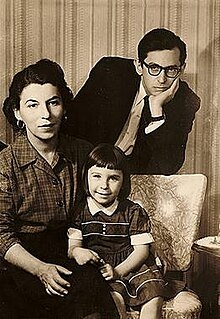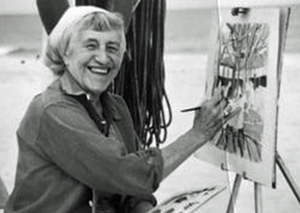Related Research Articles
Harry Shoulberg was an American expressionist painter. He was known to be among the early group of WPA artists working in the screen print (serigraph) medium, as well as oil.
Anne Ryan (1889–1954) belonged to the early generation of New York School Abstract Expressionist artists. Her first contact with the New York Avant-garde came in 1941 when she joined the Atelier 17, a famous printmaking workshop that the British artist Stanley William Hayter had established in Paris in the 1930s and then brought to New York when France fell to the Nazis. The great turning point in Anne Ryan's development occurred after the war, in 1948. She was 57 years old when she saw the collages of Kurt Schwitters at the Rose Fried Gallery, in New York City, in 1948. She right away dedicated herself to this newly discovered medium. Since Anne Ryan was a poet, according to Deborah Solomon, in Kurt Schwitters’s collages “she recognized the visual equivalent of her sonnets – discrete images packed together in an extremely compressed space.” When six years later Anne Ryan died, her work in this medium numbered over 400 pieces.
Jan Groover was an American photographer. She was widely celebrated as pivotal figure in late-twentieth century photography, and received numerous one-person shows, including at the Museum of Modern Art in New York.

Ruth Gikow was an American visual artist known primarily for her work as a genre painter. Her paintings often depict human figures interacting with an urban environment.
Riva Helfond was an American artist and printmaker best known for her social realist studies of working people's lives.

Dora Deborah Kaminsky was an American artist.

Sylvia Wald was an American visual artist. Born in Philadelphia and educated at Moore Institute of Art, she began as a painter in the style of the American social realist school, before turning to Abstract Expressionism through her pioneering work in silkscreening and sculptural collage. She has been noted for her "wide range of expression, diversity of media and technical excellence."

Ruth Starr Rose (1887–1965) was an American artist, lithographer and serigrapher best known for her paintings of African American life in Maryland in the 1930s and 1940s. This important woman artist's work is now touring throughout Maryland, the United States, and Europe as a unique example of an early American Shared Community expressed through pigment and paint. Additionally, Rose is credited as the first white artist to create a work of art for a black church. The subject of her fresco, Pharaoh's Army Got Drownded, was to honor the minister's son who perished in training for WWII.
Bernece Berkman (1911–1988), known as Bernece Berkman-Hunter after marriage, was an American painter born in Chicago, Illinois. She was inspired by what she saw in urban Chicago during the Great Depression and is best known for paintings depicting the plight of industrial workers and the poor.

Beatrice Mandelman, known as Bea, was an American abstract artist associated with the group known as the Taos Moderns. She was born in Newark, New Jersey to Anna Lisker Mandelman and Louis Mandelman, Jewish immigrants who imbued their children with their social justice values and love of the arts. After studying art in New York City and being employed by the Works Progress Administration Federal Arts Project (WPA-FAP), Mandelman arrived in Taos, New Mexico, with her artist husband Louis Leon Ribak in 1944 at the age of 32. Mandelman's oeuvre consisted mainly of paintings, prints, and collages. Much of her work was highly abstract, including her representational pieces such as cityscapes, landscapes, and still lifes. Through the 1940s, her paintings feature richly textured surfaces and a subtly modulated, often subdued color palette. New Mexico landscape and culture had a profound influence on Mandelman's style, influencing it towards a brighter palette, more geometric forms, flatter surfaces, and more crisply defined forms. One critic wrote that the "twin poles" of her work were Cubism and Expressionism. Her work is included in many major public collections, including large holdings at the University of New Mexico Art Museum and Harwood Museum of Art.
Ruth Chaney (1908-1973) was an American artist known for her printmaking.
Louise Arnstein Freedman was an American artist, known for illustration, lithography and serigraphy.

Marion Huse (1896-1967) was an American artist, known for painting and printmaking

Gladys M. Lux (1899-2003) was an American artist and educator, known for painting and printmaking.
Doris Meltzer (1908-1977) was an American artist and art dealer.

Mildred Rackley (1906-1992) was an American artist known for her printmaking. She is also known for her work in medical services in Spain during the Spanish Civil War.
Mary Van Blarcom (1913–1953) was an American artist known for her printmaking.

Francine Felsenthal was an American artist. She also used the name Francine L. Fels.
Hulda D. Robbins (1910-2011) was an American artist.
References
- 1 2 3 "Carol Weinstock". askART. Retrieved 25 January 2020.
- ↑ "Deaths". The New York Times. 22 February 1979. Retrieved 25 January 2020.
- 1 2 3 "Louis Nisonoff and Carol Weinstock papers, 1938-1976". Archives of American Art. Smithsonian Institution. Retrieved 25 January 2020.
- ↑ "Press release for "American Color Prints Under $10"" (PDF). Museum of Modern Art. Retrieved 25 January 2020.
- ↑ Dallas Museum of Fine Arts (1947). "National Serigraph Exhibition, January 15–February 15, 1947 [Checklist]". The Portal to Texas History. Retrieved 4 January 2020.